Circulator Pump Market Research: 2032
The Gobal Circulator Pump Market Size was valued at $16.4 billion in 2020, and is projected to reach $24.6 billion by 2032, growing at a CAGR of 3.4% from 2023 to 2032. A circulator pump is a type of centrifugal pump designed to circulate fluids within a closed system. These pumps are commonly used in heating, ventilation, and air conditioning (HVAC) systems, as well as in various industrial applications where the efficient movement of liquids is essential.
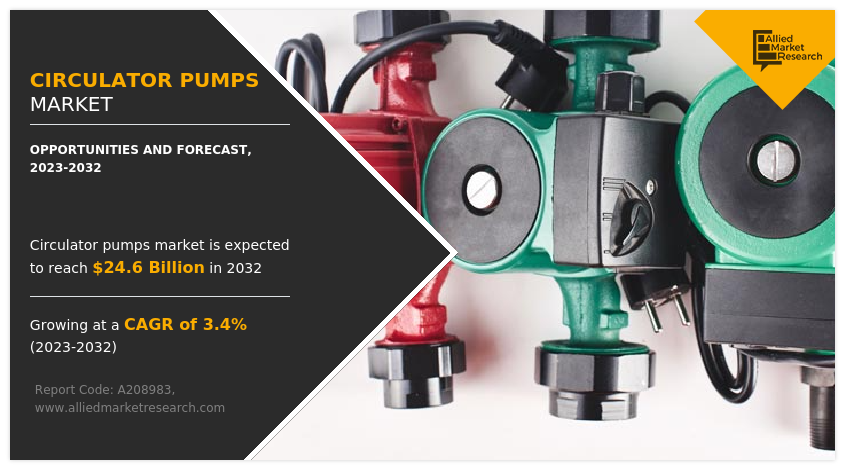
Circulator Pump Market Dynamics
The construction sector across the world, centrifugal pump especially in the Asia-Pacific is growing at a fastest pace. This is largely due to various government-backed construction projects in China, and India. For instance, in October 2021, the Dubai and Indian governments agreed to develop infrastructures such as industrial parks, multipurpose towers, logistics centers, a medical college, and a specialized hospital in the state of Jammu & Kashmir, India. The Jammu and Kashmir state experiences a significant snowfall each year driving the demand for HVAC units making use of circulator pump.
In addition, China is set to construct 10 new airports by 2035, further driving the demand for circulator pump for HVAC purpose. Circulator pump are typically employed in closed-loop systems, where the fluid (usually water or a water-glycol mixture) circulates through pipes, radiators, or other heat exchange components. In addition to HVAC systems, circulator pump are used in domestic hot water circulation systems, ensuring a continuous and efficient supply of hot water to taps and fixtures.
Moreover, by 2040, the global population is estimated to grow approximately by two billion with the urban population growing by over 40%. Population growth and rapid urbanization are expected to positively influence the construction of residential and commercial buildings. Circulator pump are commonly found in residential and commercial heating systems, where they help distribute hot water from a boiler to various heating elements, such as radiators or underfloor heating systems.
Moreover, the growing use of solar water heaters is indeed driving the demand for circulator pump. Solar water heaters are designed to harness energy from the sun to heat water for various domestic and industrial purposes. In such systems, circulator pump play a crucial role in ensuring the efficient circulation of the heated water within the solar collector, storage tank, and the distribution system. Circulator pump assist in minimizing heat loss by promoting a continuous flow of the heated fluid. This reduces the likelihood of stagnation and helps maintain the desired temperature in the solar collector and storage tank. The proper circulation facilitated by circulator pump like booster pumps enhances the performance of solar water heaters, ensuring that they operate at their designed capacity and providing reliable hot water for various applications.
However, fluctuations in the prices of steel, aluminum, and other raw materials used for manufacturing circulator pump negatively impact the profitability of the manufacturers. Thus, price fluctuation of raw materials is anticipated to restrain the circulator pump market growth. Moreover, due to the high prices of electricity, homeowners across the world are shifting towards the energy efficient circulator pump. Circulator pump is known for enhancing energy performance by providing thermal insulation, which eventually helps in reducing the electricity bill of the building. Such factors are expected to provide lucrative growth opportunities to the circulator pump market.
The circulator pump market has witnessed various obstructions in its regular operations due to the COVID-19 pandemic and inflation. Earlier, the global lockdowns resulted in reduced construction and industrial activities, eventually leading to reduced demand for circulator pump from the construction and industrial sectors. However, COVID-19 has subsided, and the major manufacturers in 2023 have been performing well. Contrarily, the rise in global inflation is a new major obstructing factor for the entire industry, which is negativelyaffecting the circulator pump market overview.
The inflation, which is a direct result of the Ukraine-Russia war and few long-term impacts of the coronavirus pandemic, has introduced volatility in the prices of raw materials used for construction which is a major end-user sector of circulator pump market. In addition, inflation is expected to worsen in the coming years, as the possibility of the ending of the war between Ukraine and Russia is less. However, a peace agreement between Ukraine and Russia can be devised, with the continued talks between different countries, which is expected to end the war between them and reduce global inflation.
Segmental Overview
The circulator pump market analysis is segmented on the basis of flow rate, end user, application, and region. By flow rate, the market is divided into Less Than 15 M3/hr, 15-30 M3 Hr, 30-45 M3/Hr, and More than 45 M3/Hr. By end user, it is categorized into residential, commercial, and industrial. By application, it is categorized into Air Conditioning, Hot water heating system, Industrial Circulation, Domestic water Recirculation, Solar and Geo Thermal Systems, and others. By region, it is analyzed across North America, Europe, Asia-Pacific, Latin America, and Middle East & Africa.
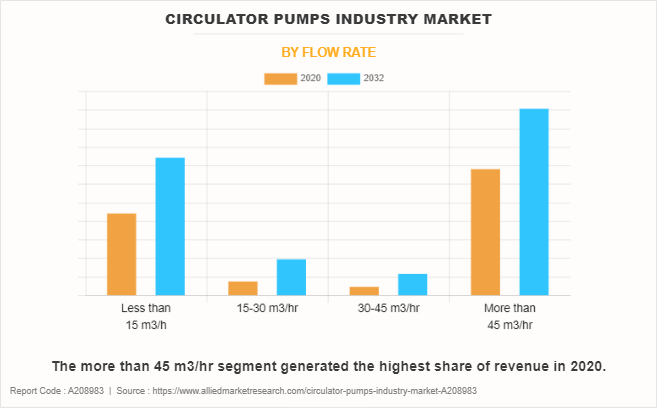
By Flow Rate:
The circulator pump market is divided into Less Than 15 M3/hr, 15-30 M3 Hr, 30-45 M3/Hr, and More than 45 M3/Hr. In 2020, the More than 45 M3/Hr segment dominated the circulator pump market, in terms of revenue. Circulator pump with more than 45 M3/Hr flow rate are relatively expensive and are used for industrial application.
Its volume sales is relatively less; however, its high price eventually leads to its dominance in the circulator pump market in terms of revenue. On the other hand, the 15-30 M3/hr segment is expected to grow with a higher CAGR due to increasing demand for circulator pump as well as hydronic pumps for domestic applications including hot water systems. This,
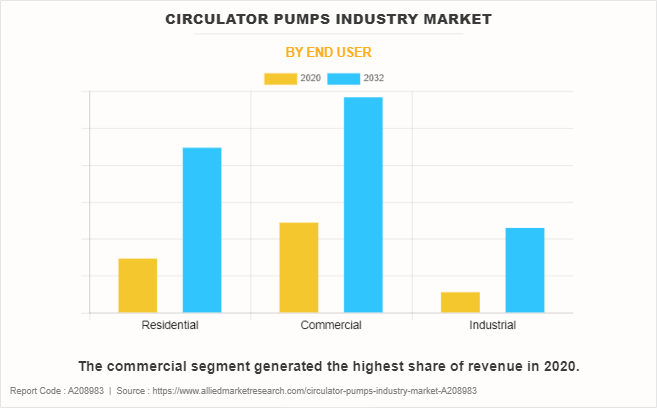
By End User:
The circulator pump market is classified into residential, commercial, and industrial. The commercial segment held a larger circulator pump market share in 2020 in terms of revenue. High demand for circulator pump for HVAC applications from commercial buildings such as corporate offices, hospitals, schools, and others is a major driving factor for the commercial segment. On the other hand, the residential segment is expected to grow with a higher CAGR during the forecast period. Growing urbanization, especially in the developing regions is a major factor behind the high growth rate of the residential segment.
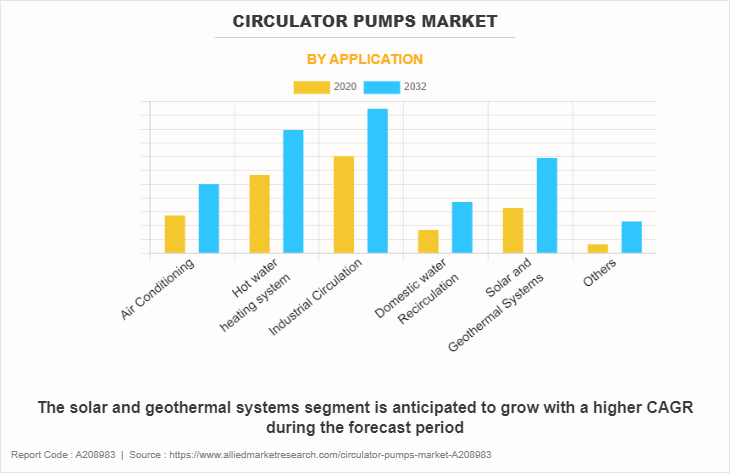
By Application:
The circulator pump market is categorized into air conditioning, hot water heating system, industrial circulation, domestic water recirculation, solar and geo thermal systems, and others. The industrial circulation segment accounted for the highest market share in terms of revenue. High capacity and expensive circulator pump are suitable for industrial application. In the addition, the number of industrial facilities has increased considerable in past few years, which has driven the demand for fluid circulation pumps. Furthermore, the solar and geothermal segment is expected to grow with the highest CAGR during the forecast period. In recent years, the popularity of sustainable practices has increased substantially. This is expected to create growth opportunities for the solar and geothermal segment.
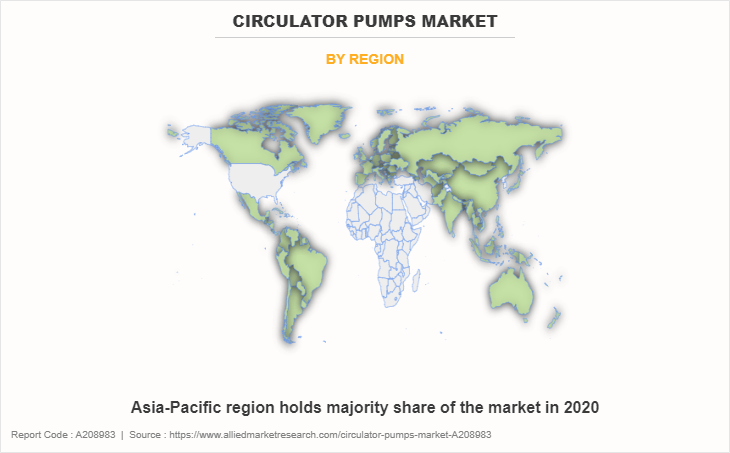
By Region:
The circulator pump market is analyzed across North America, Europe, Asia-Pacific, and LAMEA. In 2020, Asia-Pacific had the highest market share and is anticipated to secure the leading position during the forecast period. The Asia-Pacific region presents many growth opportunities to the major players in the circulator pump market, owing to rapid urbanization, and population growth in the countries such as India, South Korea, Japan, and China. For instance, China’s urban population is expected to rise to 72% in 2030 from just 64% in 2021.
In India, the industrial sector is anticipated to witness a rapid surge owing to increasing urbanization, rising economy, digitalization, growth in the IT sector, and easy foreign direct investment norms. Moreover, countries in the Middle East such as. UAE, Saudi Arabia, and Qatar are the major construction market. This provides growth opportunities for the circulator pump market in the region. Furthermore, in developed countries such as the U.S., Canada, Australia, and countries in Europe the rising tourism drives demand for highly appealing hotels, and resorts; thereby increasing the opportunities for implementing circulator pump. According to a report by the World Travel & Tourism Council (WTTC), in 2019, the total contribution of tourism to GDP was 10.6%; however, after a steep decline in 2020, its contribution to GDP climbed a positive 58.5% in 2021. In addition, public infrastructure such as airports, bus stops, railway stations, and others that make significant use of roofing is also anticipated to positively influence the market growth.
Competition Analysis
Competitive analysis and profiles of the major players in the circulator pump market such as Grundfos, Wilo SE, Taxo Cofort Solutions, Xylem Inc., Honeywell International Inc., Flowserve Corporation, Danfoss A/S, Mitsubishi Electric Corporation, Panasonic Corporation, Armstrong International, Inc., and KSB SE & Co KGaA. For example, in December 2023, Wilo USA, launched a new circulator pump. The introduction of a cutting-edge EC Motor-Driven circulator pump marks a significant advancement in the residential and commercial HVAC sector, aimed at enhancing performance while simultaneously reducing energy consumption. Likewise, KSB SE & Co KGaA unveiled a state-of-the-art high-efficiency circulation pump in May 2023. Dubbed the CalioTherm S, this innovative pump is engineered to deliver maintenance-free operation and glandless design, making it ideal for pumping drinking water within closed circuits prevalent in various settings, ranging from single-family residences to large-scale building projects.
Key Benefits for Stakeholders
- The report provides an extensive analysis of the current and emerging circulator pump market trends and dynamics.
- In-depth circulator pump market analysis is conducted by constructing market estimations for the key market segments between 2020 and 2032.
- Extensive analysis of the circulator pump market is conducted by following key product positioning and monitoring of the top competitors within the market framework.
- A comprehensive analysis of all regions is provided to determine the prevailing opportunities.
- The global circulator pump market forecast analysis from 2023 to 2032 is included in the report.
- The key market players within the circulator pump market are profiled in this report and their strategies are analyzed thoroughly, which helps understand the competitive outlook of this circulator pump industry.
Circulator Pumps Market Report Highlights
| Aspects | Details |
| Market Size By 2032 | USD 24.6 billion |
| Growth Rate | CAGR of 3.4% |
| Forecast period | 2020 - 2032 |
| Report Pages | 211 |
| By Flow Rate |
|
| By application |
|
| By End User |
|
| By Region |
|
| Key Market Players | Flowserve Corporation, Rheem Manufacturing Company, Inc., Pentair plc, Honeywell International Inc., Danfoss A/S, Armstrong Fluid Technology Inc., WILO SE, Xylem Inc., Grundfos, Taco Comfort Solutions |
Analyst Review
The growth of the circulator pump market is primarily driven by several factors, including increasing demand for energy-efficient HVAC systems and water circulation networks. Innovations such as the introduction of EC Motor-Driven circulator pumps and high-efficiency models like the CalioTherm S by KSB SE & Co KGaA have propelled market expansion by offering improved performance and reduced energy consumption. Additionally, factors such as population growth, rapid urbanization, and government-backed infrastructure projects contribute to the rising demand for circulator pumps in both residential and commercial sectors.
However, alongside these drivers, the market faces several challenges that may impact its growth trajectory. Fluctuations in raw material prices, particularly steel and aluminum, pose a significant challenge to manufacturers, affecting their profitability and pricing strategies. Moreover, geopolitical tensions and economic uncertainties can lead to volatility in the market, influencing investment decisions and consumer confidence. Additionally, regulatory requirements and compliance standards may also present hurdles for manufacturers, requiring them to adapt to evolving industry norms and regulations.
These drivers and challenges have a direct impact on the growth and performance of key manufacturers in the circulator pump market. Manufacturers that can innovate and develop energy-efficient solutions to meet changing consumer demands are likely to experience growth and gain a competitive edge. On the other hand, those that struggle to navigate challenges such as raw material price fluctuations and regulatory compliance may face obstacles in maintaining profitability and market share. Overall, the ability of manufacturers to address these drivers and challenges effectively will play a crucial role in shaping the future growth trajectory of the circulator pump market.
Key factors driving the growth of the circulator pumps market include growth in the commercial and residential buildings, and an increase in spending on making homes energy friendly.
The latest version of the global circulator pumps market report can be obtained on demand from the website.
The global circulator pumps market size was valued at $ 16.4 billion in 2020.
The global circulator pumps market size is estimated to reach $24.5 billion by 2032, exhibiting a CAGR of 3.4% from 2023 to 2032.
The forecast period considered for the global circulator pumps market is 2023 to 2032, wherein, 2022 is the base year, 2023 to 2032 is the forecast duration. Historic data is also provided from 2020 to 2021.
Asia-Pacific is the largest regional market for circulator pumps market.
Key companies profiled in the circulator pumps market report include Grundfos, Wilo SE, Taxo Cofort Solutions, Xylem Inc., Honeywell International Inc., Flowserve Corporation, Danfoss A/S, Mitsubishi Electric Corporation, Panasonic Corporation, Armstrong International, Inc., and KSB SE & Co KGaA.
The report contains an exclusive company profile section, where leading companies in the market are profiled. These profiles typically cover company overview, geographical presence, market dominance (in terms of revenue and volume sales), various strategies, and recent developments.
Loading Table Of Content...
Loading Research Methodology...



